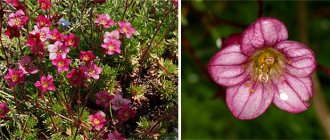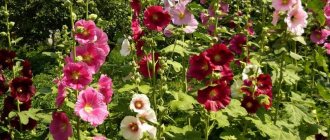Mallow or hollyhock
It’s as if nature specially created this plant for planting along hedges, fences, and walls. Mallow is unpretentious and very decorative. It also has medicinal properties. So it’s even strange that in recent years, the owners of dachas and houses have completely lost interest in mallow; it has been replaced by more “fashionable” plants. However, again, you can increasingly see tall stems of stockrose behind country fences.
Mallow along the fence
Rose mallow (Alcea rosea) is a perennial plant commonly grown as an annual or biennial. Its height reaches 250 cm. Flowers of various colors: white, pink, yellow, red, lilac, lilac, violet.
Multi-colored mallows
Cultivated since 1440, it begins to bloom 2 years after sowing, from July to September. It has many hybrid variety groups in which plants are collected according to height and flower parameters (doubleness, color).
By the way, marshmallow (Althaea officinalis), which can be bought at any pharmacy, is the closest relative of rose mallow. Rose mallow has the same beneficial properties as marshmallow, but the effect is weaker. The Latin name for marshmallow - Althaea - comes from the Greek word 'althein' - “to heal”.
Althaea officinalis - a relative of mallow
Rose mallow also has many close relatives: wrinkled mallow (Alcea rugosa), musky mallow (Malva moschata), forest mallow (Malva sylvestris), Moorish mallow (Malva mauritiana) and others. Hibiscus, lavatera and chinabelia are also distant relatives of stockrose from the same family. By crossing different types of mallows, many beautiful hybrids were obtained, which we will also definitely mention in this article.
Ads by
Description
Mallow has several names: mallow, rose stem and kalachik. The flower belongs to the Malvaceae family , and the genus unites about 30 varieties, among which there are not only tall ones, but also double and short ones.
In its natural environment, mallow can be found in temperate climates in North America, Europe, Asia and the northern regions of Africa.
The height of plant shoots can vary from 0.3 to 1.2 m. Mallow shoots can be creeping, vertically oriented or ascending. The stems of young mallows are covered with a distinct down, which disappears over time.
Large leaf plates have a round shape, reminiscent of a heart. They are attached to the stem on a small petiole and covered with short fluff.
The color of the leaves is rich green, the leaves can have from 5 to 7 lobes; There are also leaves with a notched edge.
The corollas of the mallow are large, their outlines reminiscent of a bell . The diameter of fully opened buds can reach 120 mm.
The color of the petals is completely dictated by the varietal characteristics of the plant. The variety of colors covers the palette from white to deep purple, almost black tones. The petals have an oval, inversely curved shape.
Mallow has a well-developed spindle-shaped root that goes into the ground to a decent depth.
Interesting! Mallow is resistant to temperature changes and can withstand both severe droughts and frosts with equal resistance. The flowering of the crop, starting in the first half of summer, lasts until the onset of autumn frosts.
Diseases
All varieties of hibiscus are distinguished by their unpretentiousness, but there are still some diseases that threaten them. Let's look at them and possible causes of infection.
- Spotting and powdery mildew - occurs when there is excessive soil moisture (optionally, after heavy rainfall).
- Mosaic virus.
- Stem cancer.
- Rust – infection often occurs from metal fences and supports.
To combat diseases it is necessary:
- Remove infected leaves and stems.
- Treat the bush with special preparations:
- Trichodermin.
- Phyto-doctor.
- Mikosan-V.
- Colloidal sulfur solution.
- Fungicides.
The main thing in the fight is to destroy the cause of the disease.
Annual mallow with photo
More than 50 varieties are available for cultivation . This quantity was achieved thanks to the efforts of breeders.
The ancestor of modern varieties is wood mallow, an annual plant, while the hybrid and wrinkled varieties bred on its basis are cultivated as perennials.
Forest (Malva sylvestris)
The height of the plant does not exceed 120 cm. Its distinctive feature is its large, rich pink, bell-like corollas with thin longitudinal stripes of deep purple color along the petals.
Popular varieties of wood mallow are lilac zebrina and black mother of pearl.
Purple annual
A variety with purple-pink petals. Plant height is about 100 cm.
Kinds
Mallow is one of the most common flowers around the world with a rich history. It has been cultivated for over 1000 years. During this time, several types of mallow appeared:
- Musk - is a low-growing perennial. Its height rarely exceeds 60 cm. The flowers have a light color and an incredible aroma. Their maximum diameter is 5 cm.
- Sudanese - considered both a tree plant and a shrub. Can grow up to 3 meters in height. The diameter of the flowers reaches 10 cm. The fruits can be used to prepare healthy decoctions and tinctures.
- Wrinkled - there are 2 types: dwarf and tall. Very often used to decorate a site. Blooming wrinkled mallow will transform it favorably, giving it originality and bright colors. It can reach 2 m in height.
- Hybrid is one of the tallest species. It can exceed 2 m in height. The buds are mostly white or pink.
- Forest - the highlight of this species lies in the flowers. The buds have black veins. The diameter of the flowers themselves is 7 cm.
Each species has several varieties. The most popular are “White Perfection” (musky), “Double Chater Stripe” (wrinkled), “Powder Puffs” (hybrid), “Black Pearl” (forest).
Growing annual and perennial mallow from seeds
Mallow can be grown from seeds, and the technology for perennial plants does not differ from the technique for germinating seeds of annuals.
How to grow mallow
Planting seeds of annual mallow to obtain flowering is carried out quite early this year: at the end of January - at the very beginning of February . The strengthened seedlings are transferred to the ground in mid-May.
For perennials, the sowing time for seedlings is shifted to May, and seedlings will be planted in a flowerbed no earlier than August.
Seedling
Before sowing, it is recommended to soak the seeds in warm water . This procedure will soften the hard seed coat and increase seed germination.
Mallow seeds remain viable for 3 years, and by the end of this period the percentage of germination increases noticeably.
To germinate seeds for seedlings, it is better to refuse to use a common container; give preference to individual medium-sized peat pots .
The fact is that the root system of the plant is quite delicate, it is easy to damage it when picking or transplanting seedlings into the ground. The use of peat cups eliminates this possibility.
The optimal temperature for the emergence of mallow seedlings is in the range from 18 to 22 ° C; at this temperature, the first leaves can be seen after 15–17 days.
By the time three true leaves are formed on the grown sprouts, the seedlings must be thinned out, leaving only the strongest specimens.
general characteristics
Mallow is a herbaceous plant, a typical specimen from the family of the same name. Different varieties can be either single or perennial. They grow almost all over the world, except Australia and Africa.
The graceful hollyhock, or, as it is also called, mallow, was bred even in Ancient Egypt. Hippocrates described the amazing healing properties in his treatises. Magic mallow has always delighted poets and painters.
In the natural environment, the average height ranges from 30–110 cm. The leaves are unusually heart-shaped. A flower with elongated oblong petals grows up to 13 cm. Its color depends entirely on the specific variety. The standard spectrum ranges from snowy white to rich burgundy and even almost black. For this, flower growers and landscape designers love her very much.
The root is long, spindle-shaped, strongly branched. The fruits are polyspermous. The flowering period lasts throughout the summer. Most varieties are unpretentious, resistant to both drought and frost.
Planting and care in open ground
Transferring seedlings to the ground is not difficult; the main thing is to choose the right place for planting and carefully place the plants in a permanent place .
Landing place
Try to choose well-lit areas protected from the wind. The fact is that despite their impressive growth, the stems of the mallow are quite fragile, and strong gusts of wind can damage them.
It is worth paying attention to the drainage qualities of the site - moisture should not be allowed to stagnate in the soil, this will lead to the development of rot and death of the flower .
Attention! In light shade, mallow also develops well, but the intensity of flowering will be noticeably lower than that of plants located in a well-lit place.
Soil requirements
There are no special requirements for soil quality, but on loose, nutritious soils with good air permeability, the flower develops much better than on poor, heavy substrates.
Rules for planting in open ground
It should be borne in mind that mallow is a rather tall plant. When planning a flower bed, it is planted in such a way that it does not shade lower crops .
The spacing between mallow plantings should be at least half a meter: this distance is quite enough so that the shoots do not conflict and do not shade each other.
Seeds are planted in the ground in mid-May, when the threat of return frosts has completely passed . Before planting the seeds, dig up the soil, remove the roots of weeds and make small holes about 1 cm deep.
Place 2-3 seeds in each hole and cover the plantings with soil. The flowerbed is watered. For faster emergence of seedlings, the ground can be covered with covering material.
Subsequent care for mallow will not cause any particular difficulties even for a novice gardener.
Watering
Plantings need to be watered regularly, but not too much, so as not to cause moisture to accumulate in the soil.
Loosening
After watering, when the moisture has been completely absorbed, the soil must be loosened to prevent the formation of a hard crust on the surface.
To avoid this procedure and reduce the number of weeds, the soil between flowers can be mulched .
Top dressing
Before budding, mallow can be fed with a mineral nitrogen-containing complex . Fertilizers are applied along with watering. The composition is diluted strictly according to the instructions.
Removing faded inflorescences
To preserve the decorative appearance of the flower and extend the flowering period, wilted inflorescences must be regularly removed .
Autumn and winter care
After flowering has completed, you need to remove the seeds. Then the shoots are cut to ground level, and the soil around is generously mulched with humus or peat; leaf litter can be sprinkled on top. Such shelter is quite enough for the mallow to successfully overwinter.
Transfer
Transplantation is carried out only in extreme cases . If an urgent need arises, then you need to try to remove the plant without disturbing its roots. Transplantation is carried out only by transshipment.
Beneficial features
Mallow has long been used in folk medicine. Various medicines are made from it for both internal and external use. This plant is a storehouse of vitamins A and C. It also contains carotene, iron, zinc, and mucilage, which has unique medicinal properties. The seeds themselves contain 17% fatty oils.
In folk medicine, mallow is used for:
- getting rid of diarrhea;
- healing of wounds and burns of the skin;
- treatment of cough and bronchitis;
- slowing down age-related changes;
- removing excess fluid from the body;
- relieving inflammatory processes;
- treatment of conjunctivitis;
- restoration of liver and kidney functions;
- safe weight loss;
- getting rid of chickenpox and measles.
Mallow is suitable for treating not only adults, but also children. With its help, you can strengthen your child’s immunity, get rid of skin rashes, and cure colds. It is important to consider that the culture is a medicinal plant, so you should be extremely careful when using it. Before taking it, it would be a good idea to consult with your pediatrician.
Is it possible for pregnant women
Mallow can soften toxicosis and eliminate external defects. It should be introduced into the diet only from the 2nd trimester, since at the very beginning of pregnancy doctors do not recommend the use of medicinal herbs. You can take mallow in the form of tea, decoction or tincture. The use of the plant is especially recommended if you have problems with the intestines and bladder. It effectively and safely eliminates swelling, which is especially important for most pregnant women.
In addition to medicine, mallow is also used in cosmetology. It prevents baldness, solves aesthetic problems of the skin, and also moisturizes it.
Reproduction methods
Photo: https://pixabay.com/photos/garden-spade-soil-gardening-work-1176406/
You need to know that growing mallow with seeds almost always deprives the flower of its varietal properties due to too active cross-pollination. If you have an ordinary mallow growing, then it will reproduce perfectly on its own, “scattering” its seeds around. Terry and hybrid varieties often have sterile seeds or lose their exotic coloring and decorativeness if you try to grow them using self-collected seeds.
But in addition to the seed method, you can get a “new” varietal plant by dividing the bush or cuttings.
Dividing the bush
A large bush can always be divided into two or even three sections. Divide it in the spring before vegetative growth or in the fall after flowering. The bush is dug up with a pitchfork to damage the root system as little as possible, and is divided into parts.
Each of them needs to be transplanted into a pre-prepared hole, just try to keep as much soil on the roots as possible. In this case, adaptation to a new place will be much easier.
Cuttings
The cutting method is usually used to propagate terry varieties. In spring, root cuttings are separated, and in summer and autumn, stem cuttings are separated. They can be rooted in separate containers or mini-greenhouses, covered with a glass jar or cut-off plastic bottle. Do not forget to treat the cuts with activated carbon, wood ash or potassium permanganate solution.
To make the roots “hatch” faster, you can treat the cut of the cutting with a growth stimulator, for example, “Kornevin”.
Unfortunately, if cuttings give almost one hundred percent results for other flowering plants, then in the case of mallow the effect is not so rosy. The survival rate of cuttings is very low, so flower growers do not like this method.
But if it is not possible to obtain all the varietal characteristics of a flower using another method, then you have to make an effort and achieve rooting of the cuttings. It is recommended to plant them immediately in peat pots so that adaptation to open ground is painless.











